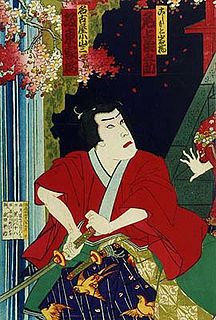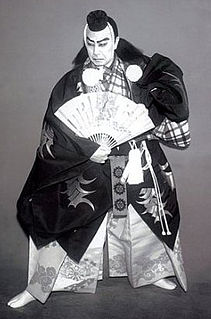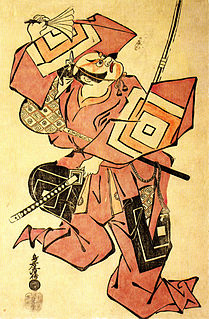
The mie, a powerful and emotional pose struck by an actor, who then freezes for a moment, is a distinctive element of aragoto Kabuki performance. Mie means 'appearance' or 'visible' in Japanese, and one of the primary purposes of this convention is to draw attention to a particularly important or powerful portion of the performance. It is meant to show a character's emotions at their peak, and can often be a very powerful pose. The actor's eyes are opened as wide as possible; if the character is meant to seem agitated or angry, the actor will cross his eyes. In Japanese, the mie pose is said to be "cut" by the actor. Audience members will shout out (kakegoe) words of praise and the actor's name at specific times before and after the pose is struck.
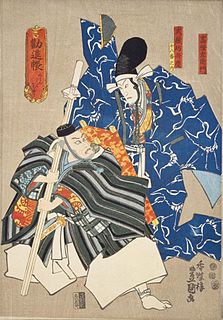
Kanjinchō is a kabuki dance-drama by Namiki Gohei III, based on the Noh play Ataka. It is one of the most popular plays in the modern kabuki repertory.
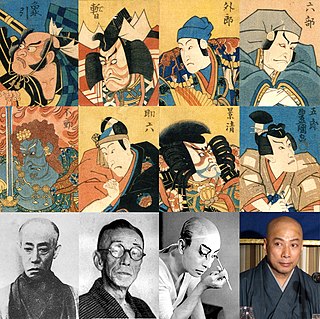
Ichikawa Danjūrō is a stage name taken on by a series of Kabuki actors of the Ichikawa family. Most of these were blood relatives, though some were adopted into the family. It is a famous and important name, and receiving it is an honor. There are a number of roles that the line of Danjūrō specialize in, as well as a series of plays, the Kabuki Jūhachiban, which showcase the specialties of the Ichikawa family.
The Kabuki Jūhachiban (歌舞伎十八番), or Eighteen Best Kabuki Plays, is a set of kabuki plays, strongly associated with the Ichikawa Danjūrō line of actors ever since their premieres. These works were chosen and assembled as "the eighteen" by actor Ichikawa Danjūrō VII (1800-1832). The pieces were considered to be seminal representations of the aragoto style in the repertoire. The Danjūrō line has continued to dominate the leading roles, and the printing and production of these plays ever since.

Ichikawa Danjūrō I was an early kabuki actor in Japan. He remains today one of the most famous of all kabuki actors and is considered one of the most influential. His many influences include the pioneering of the aragoto style of acting which came to be largely associated with Edo kabuki and with Danjūrō and his successors in the Ichikawa Danjūrō line.

Kumadori (隈取) is stage makeup worn by kabuki actors, particularly when performing in the bold and bombastic aragoto style. Kumadori makeup generally consists of brightly colored stripes or patterns over a white foundation, the colors and patterns symbolizing aspects of the actor's character. Though kumadori was originated and developed extensively by members of the Ichikawa Danjūrō line of actors, some conventions are creations of the Onoe Kikugorō line.

Ichikawa Danjūrō VIII was a Japanese kabuki actor of the prestigious Ichikawa Danjūrō line. He was a tachiyaku actor in the aragoto style, like all members of the lineage, but particularly specialized in the roles of young lovers, for which he was extremely popular.
Tōsha Rosen VI is a Japanese percussionist in the tradition of traditional Japanese dance and drama, the sixth iemoto (head) of the Tōsha school. He specializes in the taiko and tsuzumi, and performs as a member or leader of the hayashi in the kabuki theatre, as well as in a variety of other traditional contexts.
Sakata Tōjūrō IV is a Japanese kabuki actor in the Kamigata style. and is officially designated a Living National Treasure. Unlike most kabuki actors, he performs both male and female roles, and is renowned as both a skilled wagotoshi and onnagata. He is the fourth in the line of Sakata Tōjūrō, having revived the name after a lapse of over 230 years.
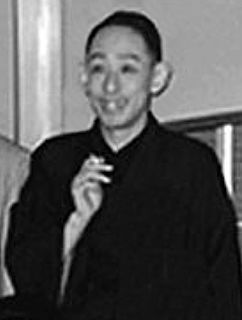
Morita Kan'ya XIV was a Japanese kabuki actor. He was a tachiyaku actor, specializing in playing the roles of young, handsome lovers in the wagoto style, a type of role known as nimaime. Kan'ya is also known for his early postwar film career, and as the adoptive father of Bandō Tamasaburō V, the most famous and popular onnagata of today.
Tachiyaku is a term used in the Japanese theatrical form kabuki to refer to young adult male roles, and to the actors who play those roles. Though not all tachiyaku roles are heroes, the term does not encompass roles such as villains or comic figures, which form their own separate categories. The hero or chief protagonist of a kabuki play is nearly always a tachiyaku role, and the head of a troupe or acting family typically specializes in these roles.

Genroku culture is the culture of the early Edo period (1603–1867), especially the Genroku era (1688–1704). Known as a period of luxurious display when the arts were increasingly patronized by a growing and powerful merchant class.

Ichikawa Danjūrō II was a Japanese kabuki performer in the lineage of a celebrated family of actors from the Edo region. Ichikawa Danjūrō is a stage name.
Sewamono (世話物) is a genre of contemporary setting plays in Japanese traditional theatre. The term applies to both bunraku and kabuki. The genre is in contrast to "period setting plays" or jidaimono. Though the distinction between "historical" and "contemporary" is not exact, and there are also plays that do not fit either category.
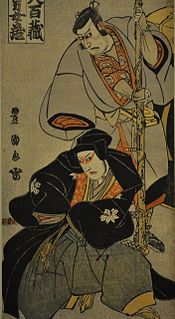
Ichikawa Omezō as a Pilgrim and Ichikawa Yaozō as a Samurai is an ukiyo-e woodblock print dating to around 1801 by Edo period artist Utagawa Toyokuni I. Featuring two of the most prominent actors of the day as characters in a contemporary kabuki drama, it is a classic example of the kabuki-e or yakusha-e genre. The print is part of the permanent collection of the Prince Takamado Gallery of Japan at the Royal Ontario Museum, Canada.



